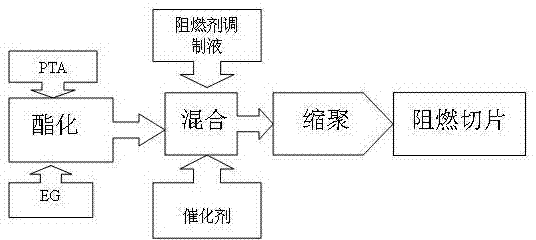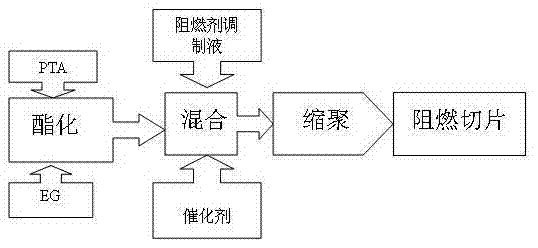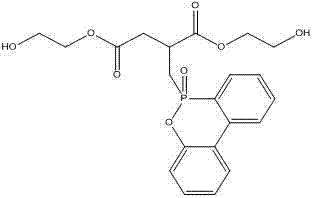Method for producing phosphorus copolymerized flame-retarding terylene high-strength industrial yarns
A technology of flame retardant and production method of copolymerization, which is applied in the field of polyester spinning, can solve the problems that the esterification temperature cannot be too high, the decomposition of flame retardant affects the flame retardant effect, and the difficulty of increasing the melt viscosity, etc., so as to reduce dyeing Effects of cost, intrinsic viscosity reduction, and high hydrolytic stability
- Summary
- Abstract
- Description
- Claims
- Application Information
AI Technical Summary
Problems solved by technology
Method used
Image
Examples
Embodiment 1
[0026] Example 1: Preparation of flame-retardant polyester chips with an intrinsic viscosity of 0.61 dL / g.
[0027] Add 75kg of EG to the preparation tank, add 25kg of flame retardant UKANOL®ES under stirring conditions, and raise the temperature to 150°C to obtain an ethylene glycol preparation solution with a flame retardant mass content of 25%. Add EG and PTA to the beating tank at a molar ratio of 1.15 for beating. After beating evenly, it will be continuously entered into the esterification tank for two-step esterification. The esterification temperature and pressure are 256°C, 80kPa, 267°C, and 4kPa, respectively. After the esterification is completed, move it into a polymerization tank, and fully mix it with the flame retardant preparation solution. After mixing evenly, perform precondensation at 277°C and 8.8kPa, and then carry out polymerization at 283°C and 1.0kPa to obtain a flame retardant polyester slice.
Embodiment 2
[0028] Example 2: The flame-retardant polyester chips synthesized in Example 1 with an intrinsic viscosity of 0.61 dL / g were used to produce polyester industrial yarns with a specification of 1110 dtex / 192f.
[0029] Feed the flame-retardant polyester chips prepared in Example 1 into the solid-state polymerization system, dry and crystallize at 160-180°C, and make the molecular chains The terminal group undergoes polycondensation reaction again to obtain a high molecular weight polymer, and the viscosity is increased to between 0.90-1.10; the high-viscosity flame-retardant polyester chips obtained after solid-state polymerization are melted into a molten state at a high temperature in a screw extruder The temperature of the spinning melt and each zone of the screw is 275°C, 275°C, 270°C, 270°C, 270°C. After static mixing, it is fully mixed during the conveying process, and then it is sprayed by high pressure of 13-30MPa in the spinning assembly. Filament, the spinning temperat...
Embodiment 3
[0030] Example 3: The flame-retardant polyester chips synthesized in Example 1 were used to produce polyester industrial yarns with a specification of 555dtex / 96f.
[0031] The preparation process of flame-retardant polyester chips and the solid-state polymerization process are the same as in Example 2, the difference is that the high-viscosity flame-retardant polyester chips obtained after solid-state polymerization are melted at high temperature in a screw extruder into a molten state spinning melt The temperature of each zone of the body and the screw is 275°C, 275°C, 270°C, 270°C, 270°C. After static mixing, it is fully mixed during the conveying process, and then it is sprayed into filaments by high pressure of 13-30MPa in the spinning assembly. The spinning temperature is 278°C, and the filaments are uniformly cooled by air-conditioned air with a temperature of 20±2°C, a humidity of 60±5%, and a speed of 0.4m / s to form primary fibers; After being coated with 0.5-1.0% hig...
PUM
| Property | Measurement | Unit |
|---|---|---|
| melting point | aaaaa | aaaaa |
| limiting oxygen index | aaaaa | aaaaa |
Abstract
Description
Claims
Application Information
 Login to View More
Login to View More - R&D
- Intellectual Property
- Life Sciences
- Materials
- Tech Scout
- Unparalleled Data Quality
- Higher Quality Content
- 60% Fewer Hallucinations
Browse by: Latest US Patents, China's latest patents, Technical Efficacy Thesaurus, Application Domain, Technology Topic, Popular Technical Reports.
© 2025 PatSnap. All rights reserved.Legal|Privacy policy|Modern Slavery Act Transparency Statement|Sitemap|About US| Contact US: help@patsnap.com



